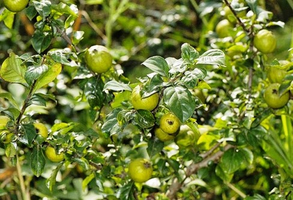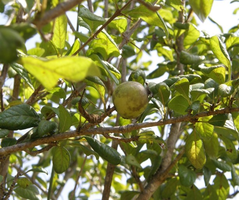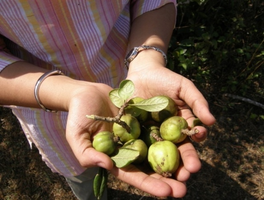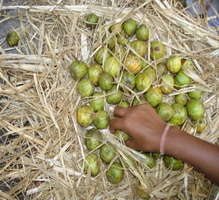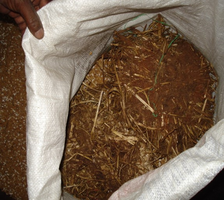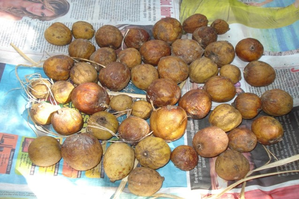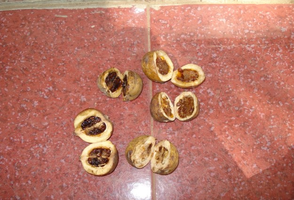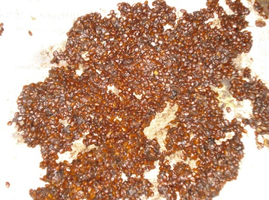Difference between revisions of "Madanakalpa Adhyaya"
m (Text replacement - "=== Introduction ===" to "== Introduction ==") |
|||
| Line 30: | Line 30: | ||
}} | }} | ||
| − | + | == Introduction == | |
In the preceding section to [[Kalpa Sthana]], i.e., in [[Chikitsa Sthana]], therapeutic emesis and purgation have been prescribed in the context of the treatment of various diseases. In this section, these recipes have been described in detail. Generally, purgation therapy is administered only after the administration of emetic therapy. Therefore the chapters describing emetic therapy are placed before the chapters dealing with purgative therapy in [[Kalpa Sthana]]. | In the preceding section to [[Kalpa Sthana]], i.e., in [[Chikitsa Sthana]], therapeutic emesis and purgation have been prescribed in the context of the treatment of various diseases. In this section, these recipes have been described in detail. Generally, purgation therapy is administered only after the administration of emetic therapy. Therefore the chapters describing emetic therapy are placed before the chapters dealing with purgative therapy in [[Kalpa Sthana]]. | ||
Revision as of 09:21, 29 May 2020
Kalpa Sthana Chapter 1. Pharmaceutical preparations of Madanaphala
Abstract
Keywords: Madanaphala, vamana, virechana
| Section/Chapter | Kalpa Sthana Chapter 1 |
|---|---|
| Preceding Chapter | None |
| Succeeding Chapter | Jimutaka Kalpa Adhyaya |
| Other Sections | Sutra Sthana, Nidana Sthana, Vimana Sthana, Sharira Sthana, Indriya Sthana, Chikitsa Sthana, Siddhi Sthana |
Introduction
In the preceding section to Kalpa Sthana, i.e., in Chikitsa Sthana, therapeutic emesis and purgation have been prescribed in the context of the treatment of various diseases. In this section, these recipes have been described in detail. Generally, purgation therapy is administered only after the administration of emetic therapy. Therefore the chapters describing emetic therapy are placed before the chapters dealing with purgative therapy in Kalpa Sthana.
Among emetic drugs, Madanaphala is considered to be the best because it does not cause any adverse effect. That explains why a chapter on Madanaphala precedes all other chapters in this section.
Kalpa means "that which is processed". In this context, pharmaceutical preparations are called Kalpa. This Sthana is called Kalpa Sthana since formulations of emetics and purgatives have been described here. The preparations which expel the dosha upwards through mouth are called Urdhavabhagahara (emetics) and those which expel downwards through rectum are Adhobhagahara (purgatives). In this section, it is explained that drugs possessing vayu and agni mahabhuta predominance initiate vamana action, while drugs with prithvi and jala predominance produce virechana action. However these actions have been attributed to principle of specific action(prabhava). It is clearly mentioned that these drugs became efficacious by the effect of desha (appropriate habitat), kala (season and time), guna (enriched with excellent attributes) and bhaajana (storing in appropriate containers).
In this reference three basic kind of desha (habitat) i.e. jangala, anupa and sadharana have been ascribed on the basis of specific flora and fauna. Laws for collection of different parts of a plant ,i.e., roots in summers or late winter when the leaves of the trees have ripened and withered away; barks, rhizome and latex in autumn; heartwood in Hemanta (early winter); and flowers and fruits during appropriate seasons have been laid out.
Since these are variations with regard to place (desha) and time (kala), preparations and processing of drugs and it is not possible to prescribe one drug which might be universally applicable. Moreover all the drugs may not be available everywhere. Hence a number of formulations of Madanaphala are described. The physician may select one out of them which is suitable for the person.
Further the number six hundred for vamana and virechana preparations is not restrictive, it is only for guidance to brilliant scholars to formulate more while it would serve as standard for average physician.
Thus, the first chapter Madanakalpa throws the light on complete Kalpa Sthana and also deals with the basic concepts to understand the habitat, collection and storage of unprocessed drugs (or ingredients) and the pharmacodynamics of vamana and virechana drugs.
Sanskrit Text, Transliteration with English Translation
अथातो मदनकल्पं व्याख्यास्यामः||१||
इति ह स्माह भगवानात्रेयः||२||
athātō madanakalpaṁ vyākhyāsyāmaḥ||1||
iti ha smāha bhagavānātrēyaḥ||2||
athAto madanakalpaM vyAkhyAsyAmaH||1||
iti ha smAha bhagavAnAtreyaH||2||
Now (I) shall expound the chapter on pharmaceutical preparations of Madana (phala). [1]
Thus said Lord Atreya. [2]
Objective of Kalpa Sthana
अथ खलु वमनविरेचनार्थं वमनविरेचनद्रव्याणां सुखोपभोगतमैः सहान्यैर्द्रव्यैर्विविधैः कल्पनार्थं भेदार्थं विभागार्थं चेत्यर्थः,तद्योगानां च क्रियाविधेः सुखोपायस्य सम्यगुपकल्पनार्थं कल्पस्थानमुपदेक्ष्यामोऽग्निवेश!||३||
atha khalu vamanavirēcanārthaṁ vamanavirēcanadravyāṇāṁ sukhōpabhōgatamaiḥsahānyairdravyairvividhaiḥ kalpanārthaṁ bhēdārthaṁ vibhāgārthaṁ cētyarthaḥ, tadyōgānāṁ cakriyāvidhēḥ sukhōpāyasya samyagupakalpanārthaṁ kalpasthānamupadēkṣyāmō'gnivēśa!||3||
atha khalu vamanavirecanArthaM [1] vamanavirecanadravyANAM sukhopabhogatamaiH sahAnyairdravyairvividhaiH kalpanArthaM bhedArthaM vibhAgArthaMcetyarthaH [2] , tadyogAnAM ca kriyAvidheH sukhopAyasya samyagupakalpanArthaM kalpasthAnamupadekShyAmo~agnivesha!||3||
Now I shall expound the section on pharmaceuticals that deals with preparations of emetic and purgative drugs, describing combinations and administration of these formulations and simple methods for the purpose of emesis and purgation, Oh Agnivesha! [3]
Vamana (therapeutic emesis) and Virechana (therapeutic purgation)
तत्र दोषहरणमूर्ध्वभागं वमनसञ्ज्ञकम्, अधोभागं विरेचनसञ्ज्ञकम्; उभयं वा शरीरमलविरेचनाद्विरेचनसञ्ज्ञां लभते||४||
tatra dōṣaharaṇamūrdhvabhāgaṁ Vamanasañjñakam, adhōbhāgaṁ virēcanasañjñakam; ubhayaṁ vāśarīramalavirēcanādvirēcanasañjñāṁ labhatē||4||
tatra doShaharaNamUrdhvabhAgaM vamanasa~jj~jakam, adhobhAgaM virecanasa~jj~jakam; ubhayaM vA sharIramalavirecanAdvirecanasa~jj~jAM labhate||4||
Of all drugs, those that eliminate impurities from the upper part are known as emetics while those that act via the lower part are called purgatives. Or (broadly), both are collectively termed as evacuatives (or purgatives) because of their purging out excrement from the body. [4]
Pharmacodynamics of Vamana
तत्रोष्ण-तीक्ष्ण-सूक्ष्म-व्यवायि-विकाशीन्यौषधानि स्ववीर्येण हृदयमुपेत्य धमनीरनुसृत्य स्थूलाणुस्रोतोभ्यः केवलं शरीरगतंदोषसङ्घातमाग्नेयत्वाद् विष्यन्दयन्ति, तैक्ष्ण्याद् विच्छिन्दन्ति, स विच्छिन्नः परिप्लवन् [१] स्नेहभाविते कायेस्नेहाक्तभाजनस्थमिवक्षौद्रमसज्जन्नणुप्रवणभावादामाशयमागम्योदानप्रणुन्नोऽग्निवाय्वात्मकत्वादूर्ध्वभागप्रभावादौषधस्योर्ध्वमुत्क्षिप्यते,सलिलपृथिव्यात्मकत्वादधोभागप्रभावाच्चौषधस्याधः प्रवर्तते, उभयतश्चोभयगुणत्वात्|
इति लक्षणोद्देशः||५||
tatrōṣṇa-tīkṣṇa-sūkṣma-vyavāyi-vikāśīnyauṣadhāni svavīryēṇa hr̥dayamupētya dhamanīranusr̥tya sthūlāṇusrōtōbhyaḥ kēvalaṁ śarīragataṁdōṣasaṅghātamāgnēyatvād viṣyandayanti, taikṣṇyād vicchindanti, sa vicchinnaḥ pariplavan [1] snēhabhāvitē kāyē snēhāktabhājanasthamivakṣaudramasajjannaṇupravaṇabhāvādāmāśayamāgamyōdānapraṇunnō' gnivāyvātmakatvādūrdhvabhāgaprabhāvādauṣadhasyōrdhvamutkṣipyatē,salilapr̥thivyātmakatvādadhōbhāgaprabhāvāccauṣadhasyādhaḥ pravartatē, ubhayataścōbhayaguṇatvāt| iti lakṣaṇōddēśaḥ||5||
tatroShNa-tIkShNa-sUkShma-vyavAyi-vikAshInyauShadhAni svavIryeNa hRudayamupetya dhamanIranusRutya sthUlANusrotobhyaH kevalaM sharIragataMdoShasa~gghAtamAgneyatvAd viShyandayanti, taikShNyAd vicchindanti, sa vicchinnaH pariplavan [1] snehabhAvite kAye snehAktabhAjanasthamivakShaudramasajjannaNupravaNabhAvAdAmAshayamAgamyodAnapraNunno~agnivAyvAtmakatvAdUrdhvabhAgaprabhAvAdauShadhasyordhvamutkShipyate,salilapRuthivyAtmakatvAdadhobhAgaprabhAvAccauShadhasyAdhaH pravartate, ubhayatashcobhayaguNatvAt| iti lakShaNoddeshaH||5||
The ushna, tikshna, sukshma, vyavayi and vikashi drugs, because of their vigorous ability in reaching the heart and circulating through the vessels, affect masses of impurity within the entire body, liquefying them and making them pass through large and small ducts (due to the fiery nature of such drugs) and detach them due to their sharpness. Consequently the detached masses left floating get ejected by udana (vayu). They get thrown upwards because of the natural composition of the drug with agni and vayu (Mahabhutas) and the specific potency (for emesis). When the natural composition of the drug predominates in jala and prithvi and there is specific potency (for purgation), it goes down. When both the above characters are combined it moves both ways. Thus the definition is said in brief. [5]
List of Drugs for Vamana and Virechana
तत्र फल-जीमूतकेक्ष्वाकु-धामार्गव-कुटज-कृतवेधनानां, श्यामा-त्रिवृच्चतुरङ्गुल-तिल्वक-महावृक्ष-सप्तला-शङ्खिनी-दन्ती-द्रवन्तीनां च, नानाविधदेशकालसम्भवास्वाद-रस-वीर्य-विपाक-प्रभावग्रहणाद् देह-दोष-प्रकृति-वयो-बलाग्नि-भक्ति-सात्म्य-रोगावस्थादीनां नानाप्रभाववत्त्वाच्च, विचित्रगन्ध-वर्ण-रस-स्पर्शानामुपयोगसुखार्थमसङ्ख्येयसंयोगानामपि चसतां द्रव्याणां विकल्पमार्गोपदर्शनार्थं षड्विरेचनयोगशतानि व्याख्यास्यामः||६||
tatra phala-jīmūtakēkṣvāku-dhāmārgava-kuṭaja-kr̥tavēdhanānāṁ, śyāmā-trivr̥ccaturaṅgula-tilvaka-mahāvr̥kṣa-saptalā-śaṅkhinī-dantī-dravantīnāṁ ca, nānāvidhadēśakālasambhavāsvāda-rasa-vīrya-vipāka-prabhāvagrahaṇād dēha-dōṣa-prakr̥ti-vayō-balāgni-bhakti-sātmya-rōgāvasthādīnāṁnānāprabhāvavattvācca, vicitragandha-varṇa-rasa-sparśānāmupayōgasukhārthamasaṅkhyēyasaṁyōgānāmapi ca satāṁ dravyāṇāṁvikalpamārgōpadarśanārthaṁ ṣaḍvirēcanayōgaśatāni vyākhyāsyāmaḥ||6||
tatra phala-jImUtakekShvAku-dhAmArgava-kuTaja-kRutavedhanAnAM, shyAmA-trivRuccatura~ggula-tilvaka-mahAvRukSha-saptalA-sha~gkhinI-dantI-dravantInAMca, nAnAvidhadeshakAlasambhavAsvAda-rasa-vIrya-vipAka-prabhAvagrahaNAd [1] deha-doSha-prakRuti-vayo-balAgni-bhakti-sAtmya-rogAvasthAdInAMnAnAprabhAvavattvAcca [2] , vicitragandha-varNa-rasa-sparshAnAmupayogasukhArthamasa~gkhyeyasaMyogAnAmapi [3] ca satAM dravyANAMvikalpamArgopadarshanArthaM ShaDvirecanayogashatAni vyAkhyAsyAmaH||6||
Here I will describe six hundred evacuative formulations involving Madanaphala, jimuta, ikshvaku, dhamargava, kutaja and kritvedhana (all emetics); shyama, trivrita, chaturangula, tilvaka, mahavriksha, saptala, shankhini, danti - there are innumerable combinations of drugs due to variations in habitat, place and time; taste, Rasa, Virya, Vipaka and Prabhava (of drugs); in body, morbidity, constitution, age, strength, agni, inclination, suitability, states of disease etc. (of the patient) and in smell, color, taste and touch (of vehicles and subsidiary drugs) for easy administration. [6]
तानि तु द्रव्याणि देश-काल-गुण-भाजन-सम्पद्वीर्यबलाधानात् क्रियासमर्थतमानि भवन्ति||७||
tāni tu dravyāṇi dēśa-kāla-guṇa-bhājana-sampadvīryabalādhānāt kriyāsamarthatamāni bhavanti||7||
tAni tu dravyANi desha-kAla-guNa-bhAjana-sampadvIryabalAdhAnAt kriyAsamarthatamAni bhavanti||7||
These drugs are the most potent when they are exposed to the most suitable of place, time, properties and containers. [7]
Three Types of Desha (regions or habitats)
त्रिविधः खलु देशः- जाङ्गलः, आनूपः, साधारणश्चेति|
तत्र जाङ्गलः पर्याकाशभूयिष्ठः, तरुभिरपि च कदर-खदिरासनाश्वकर्ण-धव-तिनिश-शल्लकी-साल-सोमवल्क-बदरी-तिन्दुकाश्वत्थ-वटामलकीवनगहनः, अनेकशमी-ककुभ-शिंशपाप्रायः, स्थिरशुष्कपवनबलविधूयमानप्रनृत्यत्तरुणविटपः,प्रततमृगतृष्णिकोपगूढतनुखरपरुषसिकताशर्कराबहुलः, लावतित्तिरिचकोरानुचरितभूमिभागः, वातपित्तबहुलः,स्थिरकठिनमनुष्यप्रायो ज्ञेयः, अथानूपो हिन्तालतमालनारिकेलकदलीवनगहनः, सरित्समुद्रपर्यन्तप्रायः, शिशिरपवनबहुलः,वञ्जुलवानीरोपशोभिततीराभिः सरिद्भिरुपगतभूमिभागः, क्षितिधरनिकुञ्जोपशोभितः, मन्दपवनानुवीजितक्षितिरुहगहनः,अनेकवनराजीपुष्पितवनगहनभूमिभागः, स्निग्धतरुप्रतानोपगूढः, हंस-चक्रवाक-बलाका-नन्दीमुख-पुण्डरीक-कादम्ब-मद्गु -भृङ्गराज-शतपत्र-मत्तकोकिलानुनादिततरुविटपः, सुकुमारपुरुषः, पवनकफप्रायो ज्ञेयः; अनयोरेवद्वयोर्देशयोर्वीरुद्वनस्पतिवानस्पत्यशकुनिमृगगणयुतः स्थिरसुकुमारबलवर्णसंहननोपपन्नसाधारणगुणयुक्तपुरुषःसाधारणो ज्ञेयः||८||
trividhaḥ khalu dēśaḥ- jāṅgalaḥ, ānūpaḥ, sādhāraṇaścēti|
tatra jāṅgalaḥ paryākāśabhūyiṣṭhaḥ, tarubhirapi ca kadara-khadirāsanāśvakarṇa-dhava-tiniśa-śallakī-sāla-sōmavalka-badarī-tindukāśvattha-vaṭāmalakīvanagahanaḥ, anēkaśamī-kakubha-śiṁśapāprāyaḥ,sthiraśuṣkapavanabalavidhūyamānapranr̥tyattaruṇaviṭapaḥ, pratatamr̥gatr̥ṣṇikōpagūḍhatanukharaparuṣasikatāśarkarābahulaḥ, lāvatittiricakōrānucaritabhūmibhāgaḥ,vātapittabahulaḥ, sthirakaṭhinamanuṣyaprāyō jñēyaḥ, athānūpō hintālatamālanārikēlakadalīvanagahanaḥ,saritsamudraparyantaprāyaḥ, śiśirapavanabahulaḥ, vañjulavānīrōpaśōbhitatīrābhiḥsaridbhirupagatabhūmibhāgaḥ, kṣitidharanikuñjōpaśōbhitaḥ, mandapavanānuvījitakṣitiruhagahanaḥ,anēkavanarājīpuṣpitavanagahanabhūmibhāgaḥ, snigdhatarupratānōpagūḍhaḥ, haṁsa-cakravāka-balākā-nandīmukha-puṇḍarīka-kādamba-madgu -bhr̥ṅgarāja-śatapatra-mattakōkilānunāditataruviṭapaḥ, sukumārapuruṣaḥ, pavanakaphaprāyō jñēyaḥ; anayōrēvadvayōrdēśayōrvīrudvanaspativānaspatyaśakunimr̥gagaṇayutaḥsthirasukumārabalavarṇasaṁhananōpapannasādhāraṇaguṇayuktapuruṣaḥ sādhāraṇō jñēyaḥ||8||
trividhaH khalu deshaH- jA~ggalaH, AnUpaH, sAdhAraNashceti|
tatra jA~ggalaH paryAkAshabhUyiShThaH, tarubhirapi ca kadara-khadirAsanAshvakarNa-dhava-tinisha-shallakI-sAla-somavalka-badarI-tindukAshvattha-vaTAmalakIvanagahanaH, anekashamI-kakubha-shiMshapAprAyaH, sthirashuShkapavanabalavidhUyamAnapranRutyattaruNaviTapaH,pratatamRugatRuShNikopagUDhatanukharaparuShasikatAsharkarAbahulaH, lAvatittiricakorAnucaritabhUmibhAgaH, vAtapittabahulaH, sthirakaThinamanuShyaprAyoj~jeyaH, athAnUpo hintAlatamAlanArikelakadalIvanagahanaH, saritsamudraparyantaprAyaH, shishirapavanabahulaH, va~jjulavAnIropashobhitatIrAbhiHsaridbhirupagatabhUmibhAgaH, kShitidharaniku~jjopashobhitaH, mandapavanAnuvIjitakShitiruhagahanaH, anekavanarAjIpuShpitavanagahanabhUmibhAgaH,snigdhatarupratAnopagUDhaH, haMsa-cakravAka-balAkA-nandImukha-puNDarIka-kAdamba-madgu [1] -bhRu~ggarAja-shatapatra-mattakokilAnunAditataruviTapaH,sukumArapuruShaH, pavanakaphaprAyo j~jeyaH; anayoreva dvayordeshayorvIrudvanaspativAnaspatyashakunimRugagaNayutaHsthirasukumArabalavarNasaMhananopapannasAdhAraNaguNayuktapuruShaH sAdhAraNo j~jeyaH||8||
A region could be of three types – arid, marshy and medium/normal. Of these, the arid zone is primarily sparse. As regards plants, there are dense fruits of Kadara, Khadira, Asana, Aswakarna, Dhava, Tinisa, Sallaki, Sala, Somavalka, Badari, Tinduka, Asvaittha, Vata and Amalaki, predominance of Sami, Kakubha and Shimshipa, young (immature) plants that are firm, dry and those that, when shaken with severe winds, sway vigorously as if dancing. The land abounds in mirages, is thin, coarse, rough and abounds in sand and gravels. The region is inhabited by birds such as the common quail, partridge, chakora. The place abounds in vata and pitta and is inhabited mostly by firm and hard people.
Marshy regions have dense forests of Hintala, Tamala,, coconut trees, and banana plants. These lands adjoin coasts of sea and rivers, abounding in cold breeze. The land is intercepted by water streams having Vanjula and Vanira (willow) plants on banks, adorned with hills and bowers, abounding in trees attended by mild breeze. The region is full of rows of flowered plants in abundance, embraced with amorous branches of trees resounding with coos of swan, Chakravaka, crane, Nandimukha, Pundanka, Kadamba, Madgu, Bhringaraja, Sataparna and the intoxicatingly sweet koyal. The region is typically inhabited by delicate people and is dominated by vata and kapha.
A region is considered to be of medium or normal kind that has the combined characters of the above two in respect of plants, birds and animals and is inhabited by people firm, delicate, endowed with strength, complexion and compactness and other medium qualities. [8]
Characteristics of a Suitable Desha for Medicinal Plants
तत्र देशे साधारणे जाङ्गले वा यथाकालं शिशिरातपपवनसलिलसेविते समे शुचौ प्रदक्षिणोदके श्मशान-चैत्य-देवयजनागार-सभा-श्वभ्राराम-वल्मीकोषरविरहिते कुशरोहिषास्तीर्णे स्निग्धकृष्णमधुरमृत्तिके सुवर्णवर्णमधुरमृत्तिके वामृदावफालकृष्टेऽनुपहतेऽन्यैर्बलवत्तरैर्द्रुमैरौषधानि जातानि प्रशस्यन्ते||९||
tatra dēśē sādhāraṇē jāṅgalē vā yathākālaṁ śiśirātapapavanasalilasēvitē samē śucau pradakṣiṇōdakēśmaśāna-caitya-dēvayajanāgāra-sabhā-śvabhrārāma-valmīkōṣaravirahitē kuśarōhiṣāstīrṇēsnigdhakr̥ṣṇamadhuramr̥ttikē suvarṇavarṇamadhuramr̥ttikē vāmr̥dāvaphālakr̥ṣṭē'nupahatē'nyairbalavattarairdrumairauṣadhāni jātāni praśasyantē||9|
tatra deshe sAdhAraNe jA~ggale vA yathAkAlaM shishirAtapapavanasalilasevite same shucau pradakShiNodake shmashAna-caitya-devayajanAgAra-sabhA-shvabhrArAma-valmIkoSharavirahite kusharohiShAstIrNe snigdhakRuShNamadhuramRuttike suvarNavarNamadhuramRuttike vAmRudAvaphAlakRuShTe~anupahate~anyairbalavattarairdrumairauShadhAni jAtAni prashasyante||9||
Medicinal plants grown in medium or arid zones, nourished timely with cold, sun (heat), air and water, even, clean, with facilities of water, except cremation ground, sacred place, temple, meeting place, ditch, orchard, ant-hills and barren land, covered with kusha and rohisha plants, having unctuous, black, sweet or golden sweet soil, soft, unploughed,and unaffected by other stronger plants are recommended (for us). [9]
Method of Collection of Medicinal Plants
तत्र यानि कालजातान्युपागतसम्पूर्णप्रमाण-रसवीर्य-गन्धानि कालातपाग्निसलिलपवनजन्तुभिरनुपहतगन्ध-वर्ण-रस-स्पर्श-प्रभावाणि प्रत्यग्राण्युदीच्यां दिशि स्थितानि; तेषां शाखापलाशमचिरप्ररूढं वर्षावसन्तयोर्ग्राह्यं, ग्रीष्मे मूलानि शिशिरे वाशीर्णप्ररूढपर्णानां, शरदि त्वक्कन्दक्षीराणि, हेमन्ते साराणि, यथर्तु पुष्पफलमिति; मङ्गलाचारः कल्याणवृत्तः शुचिःशुक्लवासाः सम्पूज्य देवता अश्विनौ गोब्राह्मणांश्च कृतोपवासः प्राङ्मुख उदङ्मुखो वा गृह्णीयात्||१०||
tatra yāni kālajātānyupāgatasampūrṇapramāṇa-rasavīrya-gandhāni kālātapāgnisalilapavanajantubhiranupahatagandha-varṇa-rasa-sparśa-prabhāvāṇi pratyagrāṇyudīcyāṁdiśi sthitāni; tēṣāṁ śākhāpalāśamaciraprarūḍhaṁ varṣāvasantayōrgrāhyaṁ, grīṣmē mūlāni śiśirē vāśīrṇaprarūḍhaparṇānāṁ, śaradi tvakkandakṣīrāṇi, hēmantē sārāṇ,yathartu puṣpaphalamiti;maṅgalācāraḥ kalyāṇavr̥ttaḥ śuciḥ śuklavāsāḥ sampūjya dēvatā aśvinau gōbrāhmaṇāṁśca kr̥tōpavāsaḥprāṅmukha udaṅmukhō vā gr̥hṇīyāt||10||
tatra yAni kAlajAtAnyupAgatasampUrNapramANa-rasavIrya-gandhAni [1] kAlAtapAgnisalilapavanajantubhiranupahatagandha-varNa-rasa-sparsha-prabhAvANipratyagrANyudIcyAM dishi sthitAni; teShAM shAkhApalAshamaciraprarUDhaM varShAvasantayorgrAhyaM, grIShme mUlAni shishire vA shIrNaprarUDhaparNAnAM,sharadi tvakkandakShIrANi, hemante sArANi, yathartu puShpaphalamiti; ma~ggalAcAraH kalyANavRuttaH shuciH shuklavAsAH sampUjya devatA ashvinaugobrAhmaNAMshca kRutopavAsaH prA~gmukha uda~gmukho vA gRuhNIyAt||10||
Of all medicinal plants, those that are grown in time (proper season), grow mature with taste, potency and smell; have smell, color, taste, touch and efficacy unaffected by time, sun, fire, water, air and organisms, are fresh and situated in northern direction (should be collected). Their branches and leaves should be collected in rainy seasons and when those plants are fully matured; bark, tubers and latex should be collected in autumn; heartwood in early winter and flowers and fruits according to their season. These should be collected by one with auspicious behavior, benevolent conduct, cleanliness and white dress after worshiping, observing fast and facing toward east or north. [10]
Method of Storage
गृहीत्वा चानुरूपगुणवद्भाजनस्थान्यागारेषू प्रागुदग्द्वारेषु निवातप्रवातैकदेशेषु नित्यपुष्पोपहारबलिकर्मवत्सु, अग्नि-सलिलोपस्वेद-धूम-रजो-मूषक-चतुष्पदामनभिगमनीयानि स्ववच्छन्नानि शिक्येष्वासज्य स्थापयेत्||११||
gr̥hītvā cānurūpaguṇavadbhājanasthānyāgārēṣū prāgudagdvārēṣu nivātapravātaikadēśēṣunityapuṣpōpahārabalikarmavatsu, agni-salilōpasvēda-dhūma-rajō-mūṣaka-catuṣpadāmanabhigamanīyānisvavacchannāni śikyēṣvāsajya sthāpayēt||11||
gRuhItvA cAnurUpaguNavadbhAjanasthAnyAgAreShU [1] prAgudagdvAreShu nivAtapravAtaikadesheShu nityapuShpopahArabalikarmavatsu, agni-salilopasveda-dhUma-rajo-mUShaka-catuShpadAmanabhigamanIyAni svavacchannAni shikyeShvAsajya sthApayet||11||
After collecting the plant extracts, they should be kept in suitable containers and stored in rooms facing eastward or northward, devoid of wind but well ventilated , and daily ritualized with offering of flower and other things, holding them up in a swing of rope well-covered and making them unapproachable for fire, water, humidity, smoke, dust, rats and quadrupeds. [11]
Administration per Dosha Dominance
तानि च यथादोषं प्रयुञ्जीत सुरा-सौवीरक-तुषोदक-मैरेय-मेदक-धान्याम्ल -फलाम्ल-दध्यम्लादिभिर्वाते, मृद्वीकामलक -मधु-मधुक-परूषक-फाणितक्षीरादिभिः पित्ते, श्लेष्मणि तु मधु-मूत्र-कषायादिभिर्भावितान्यालोडितानि च; इत्युद्देशः|
तं विस्तरेण द्रव्य-देह-दोष-सात्म्यादीनि प्रविभज्य व्याख्यास्यामः||१२||
tāni ca yathādōṣaṁ prayuñjīta surā-sauvīraka-tuṣōdaka-mairēya-mēdaka-dhānyāmla -phalāmla-dadhyamlādibhirvātē, mr̥dvīkāmalaka -madhu-madhuka-parūṣaka-phāṇitakṣīrādibhiḥ pittē, ślēṣmaṇi tumadhu-mūtra- kaṣāyādibhirbhāvitānyālōḍitāni ca; ityuddēśaḥ| taṁ vistarēṇa dravya-dēha-dōṣa-sātmyādīni pravibhajya vyākhyāsyāmaḥ||12||
tAni ca yathAdoShaM prayu~jjIta surA-sauvIraka-tuShodaka-maireya-medaka-dhAnyAmla [1] -phalAmla-dadhyamlAdibhirvAte, mRudvIkAmalaka [2] -madhu-madhuka-parUShaka-phANitakShIrAdibhiH pitte, shleShmaNi tu madhu-mUtra-kaShAyAdibhirbhAvitAnyAloDitAni ca; ityuddeshaH| taM vistareNa dravya-deha-doSha-sAtmyAdIni [3] pravibhajya vyAkhyAsyAmaH||12||
These (drugs) should be administered according to the relevant dosha, with an appropriate vehicle/medium such as wine, Sauviraka, Tusodaka, Maireya, Medaka, Dhanyamla, Phalamla, sour curd, etc. in vata; grapes, Amalaka, honey, Madhuka, Parusaka, Phanita, milk etc. in pitta and in kapha impregnated with or dissolved in honey, urine and decoction etc. This is in a nutshell. This will be explained further in details according to drugs, body, morbidity, suitability etc. [12]
Administration of Madanaphala
वमनद्रव्याणां मदनफलानि श्रेष्ठतमान्याचक्षते, अनपायित्वात्|
तानि वसन्तग्रीष्मयोरन्तरे [पुष्याश्वयुग्भ्यां मृगशिरसा वा गृह्णीयान्मैत्रे मुहूर्ते|
यानि पक्वान्यकाणान्यहरितानि पाण्डून्यक्रिमीण्यपूतीन्यजन्तुजग्धान्यह्रस्वानि; तानि प्रमृज्य , कुशपुटे बद्ध्वा,गोमयेनालिप्य, यवतु(बु)षमाषशालिकुलत्थमुद्गपलानामन्यतमे निदध्यादष्टरात्रम्|
अत ऊर्ध्वं मृदूभूतानि मध्विष्टगन्धान्युद्धृत्य शोषयेत्|
सुशुष्काणां फलपिप्पलीरुद्धरेत् |
तासां घृतदधिमधुपललविमृदितानां पुनः शुष्काणां नवं कलशं सुप्रमृष्टवालुकमरजस्कमाकण्ठं पूरयित्वा स्ववच्छन्नं स्वनुगुप्तंशिक्येष्वासज्य सम्यक् स्थापयेत्||१३||
vamanadravyāṇāṁ madanaphalāni śrēṣṭhatamānyācakṣatē, anapāyitvāt|
tāni vasantagrīṣmayōrantarē puṣyāśvayugbhyāṁ mr̥gaśirasā vā gr̥hṇīyānmaitrē muhūrtē|
yāni pakvānyakāṇānyaharitāni pāṇḍūnyakrimīṇyapūtīnyajantujagdhānyahrasvāni; tāni pramr̥jya ,kuśapuṭē baddhvā, gōmayēnālipya, yavatu(bu)ṣamāṣaśālikulatthamudgapalānāmanyatamē nidadhyādaṣṭarātram| ata ūrdhvaṁ mr̥dūbhūtāni madhviṣṭagandhānyuddhr̥tya śōṣayēt|
suśuṣkāṇāṁ phalapippalīruddharēt |
tāsāṁ ghr̥tadadhimadhupalalavimr̥ditānāṁ punaḥ śuṣkāṇāṁ navaṁ kalaśaṁsupramr̥ṣṭavālukamarajaskamākaṇṭhaṁ pūrayitvā svavacchannaṁ svanuguptaṁ śikyēṣvāsajya samyaksthāpayēt||13||
vamanadravyANAM madanaphalAni shreShThatamAnyAcakShate, anapAyitvAt| tAni vasantagrIShmayorantare [1] puShyAshvayugbhyAM mRugashirasA vA gRuhNIyAnmaitre muhUrte| yAni pakvAnyakANAnyaharitAni pANDUnyakrimINyapUtInyajantujagdhAnyahrasvAni; tAni pramRujya [2] , kushapuTe baddhvA, gomayenAlipya,yavatu(bu)ShamAShashAlikulatthamudgapalAnAmanyatame [3] nidadhyAdaShTarAtram| ata UrdhvaM mRudUbhUtAni madhviShTagandhAnyuddhRutya shoShayet| sushuShkANAM phalapippalIruddharet [4] | tAsAM ghRutadadhimadhupalalavimRuditAnAM punaH shuShkANAM navaM kalashaM supramRuShTavAlukamarajaskamAkaNThaM pUrayitvA svavacchannaMsvanuguptaM shikyeShvAsajya [5] samyak sthApayet||13||
Of all the emetic drugs, Madana fruits are regarded as the best ones because they are free from complications. These should be collected during the period of transition between spring and summer in Pusya, Aswini or Mrigasiras constellation and Maitra Muhurta. Those which are ripe, undamaged, non-green, of pale color, free organisms, under-composed, uneaten by animals, not too small (immature) should be taken. Having been washed, wrapped within Kusa grass and pasted with fresh cow-dung they should be stored for eight days in the heap of one of the following-barley husk, black gram, Sali rice, horse gram and green gram. Thereafter when they are softened and develop good honey-like aroma they should be taken out and dried (in the sun). When they are well-dried, their pepper-like seeds should be mixed gently with ghee, curd, honey and sesamum paste and again dried. Finally they should be filled up in a new earthen pitcher, well-cleaned and dustless, up to neck and placed well on a swing of rope well-covered and well-protected. [13]
Procedure of Vamana
अथ च्छर्दनीयमातुरं द्व्यहं त्र्यहं वा स्नेहस्वेदोपपन्नं श्वश्छर्दयितव्यमिति ग्राम्यानूपौदकमांसरस-क्षीर-दधि-माष-तिल-शाकादिभिः समुत्क्लेशितश्लेष्माणं व्युषितं जीर्णाहारं पूर्वाह्णे कृतबलिहोममङ्गलप्रायश्चित्तं निरन्नमनतिस्निग्धं यवाग्वाघृतमात्रां पीतवन्तं, तासां फलपिप्पलीनामन्तर्नखमुष्टिं यावद्वा साधु मन्येत जर्जरीकृत्य यष्टिमधुकषायेण कोविदार-कर्बुदार-नीप-विदुल-बिम्बी-शणपुष्पी-सदापुष्पी-प्रत्यक्पुष्पीकषायाणामन्यतमेन वा रात्रिमुषितं विमृद्य पूतं मधुसैन्धवयुक्तंसुखोष्णं कृत्वा पूर्णं शरावं मन्त्रेणानेनाभिमन्त्रयेत्- ‘ॐ ब्रह्मदक्षाश्विरुद्रेन्द्रभूचन्द्रार्कानिलानलाः| ऋषयः सौषधिग्रामा भूतसङ्घाश्च पान्तु ते|
रसायनमिवर्षीणां देवानाममृतं यथा| सुधेवोत्तमनागानां भैषज्यमिदमस्तु ते’|
इत्येवमभिमन्त्र्योदङ्मुखं प्राङ्मुखं वाऽऽतुरं पाययेच्छ्लेष्मज्वरगुल्मप्रतिश्यायार्तं विशेषेण पुनः पुनरापित्तागमनात्, तेन साधुवमति; हीनवेगं तु पिप्पल्यामलक-सर्षप-वचाकल्कलवणोष्णोदकैः पुनः पुनः प्रवर्तयेदापित्तदर्शनात्|
इत्येष सर्वश्छर्दनयोगविधिः||१४||
atha cchardanīyamāturaṁ dvyahaṁ tryahaṁ vā snēhasvēdōpapannaṁ śvaśchardayitavyamitigrāmyānūpaudakamāṁsarasa-kṣīra-dadhi-māṣa-tila-śākādibhiḥ samutklēśitaślēṣmāṇaṁ vyuṣitaṁjīrṇāhāraṁ pūrvāhṇē kr̥tabalihōmamaṅgalaprāyaścittaṁ nirannamanatisnigdhaṁ yavāgvā ghr̥tamātrāṁpītavantaṁ, tāsāṁ phalapippalīnāmantarnakhamuṣṭiṁ yāvadvā sādhu manyēta jarjarīkr̥tyayaṣṭimadhukaṣāyēṇa kōvidāra-karbudāra-nīpa-vidula-bimbī-śaṇapuṣpī-sadāpuṣpī-pratyakpuṣpī-kaṣāyāṇāmanyatamēna vā rātrimuṣitaṁ vimr̥dya pūtaṁ madhusaindhavayuktaṁ sukhōṣṇaṁ kr̥tvā pūrṇaṁśarāvaṁ mantrēṇānēnābhimantrayēt- ‘ōṁ brahmadakṣāśvirudrēndrabhūcandrārkānilānalāḥ|
r̥ṣayaḥ sauṣadhigrāmā bhūtasaṅghāśca pāntu tē|
rasāyanamivarṣīṇāṁ dēvānāmamr̥taṁ yathā|
sudhēvōttamanāgānāṁ bhaiṣajyamidamastu tē’|
ityēvamabhimantryōdaṅmukhaṁ prāṅmukhaṁ vāturaṁ pāyayēcchlēṣmajvaragulmapratiśyāyārtaṁviśēṣēṇa punaḥ punarāpittāgamanāt, tēna sādhu vamati; hīnavēgaṁ tu pippalyāmalaka-sarṣapa-vacākalkalavaṇōṣṇōdakaiḥ punaḥ punaḥ pravartayēdāpittadarśanāt| ityēṣa sarvaśchardanayōgavidhiḥ||14||
atha cchardanIyamAturaM dvyahaM tryahaM vA snehasvedopapannaM shvashchardayitavyamiti grAmyAnUpaudakamAMsarasa-kShIra-dadhi-mASha-tila-shAkAdibhiH samutkleshitashleShmANaM vyuShitaM jIrNAhAraM pUrvAhNe kRutabalihomama~ggalaprAyashcittaM nirannamanatisnigdhaM yavAgvA ghRutamAtrAMpItavantaM, tAsAM phalapippalInAmantarnakhamuShTiM yAvadvA sAdhu manyeta jarjarIkRutya yaShTimadhukaShAyeNa kovidAra-karbudAra-nIpa-vidula-bimbI-shaNapuShpI-sadApuShpI-pratyakpuShpI-kaShAyANAmanyatamena vA rAtrimuShitaM vimRudya pUtaM madhusaindhavayuktaM sukhoShNaM kRutvA pUrNaMsharAvaM mantreNAnenAbhimantrayet- ‘OM brahmadakShAshvirudrendrabhUcandrArkAnilAnalAH| RuShayaH sauShadhigrAmA bhUtasa~gghAshca pAntu te| rasAyanamivarShINAM devAnAmamRutaM yathA| sudhevottamanAgAnAM bhaiShajyamidamastu te’| ityevamabhimantryoda~gmukhaM prA~gmukhaM vA~a~aturaM pAyayecchleShmajvaragulmapratishyAyArtaM visheSheNa punaH punarApittAgamanAt, tena sAdhuvamati; hInavegaM tu pippalyAmalaka-sarShapa-vacAkalkalavaNoShNodakaiH punaH punaH pravartayedApittadarshanAt| ityeSha sarvashchardanayogavidhiH||14||
“Brahma, Daksa, Asvina, Rudra, Indra, Earth, Moon, Sun, Air, Fire, Sages, medicinal plants and multitude of creatures may protect you.This drug may prove for you as Rasayana for the sages, nectar for the gods and ambrosia for the best among serpents.”
After enchanting thus, the physician should administer the drug to the patient facing northward or eastward particularly suffering from kaphaja fever, gulma and coryza time and again until bile begins to come out. Thus he vomits well. If the urges are deficient, they should be moved by administering paste of Pippali, Amalaka, Sarsapa, Vacha and salt dissolved in hot water frequently till bile is seen. This is the entire method of administration of emetic drugs. [14]
सर्वेषु तु मधुसैन्धवं कफविलयनच्छेदार्थं वमनेषु विदध्यात्|
न चोष्णविरोधो मधुनश्छर्दनयोगयुक्तस्य, अविपक्वप्रत्यागमनाद्दोषनिर्हरणाच्च||१५||
sarvēṣu tu madhusaindhavaṁ kaphavilayanacchēdārthaṁ vamanēṣu vidadhyāt|
na cōṣṇavirōdhō madhunaśchardanayōgayuktasya, avipakvapratyāgamanāddōṣanirharaṇācca||15||
sarveShu tu madhusaindhavaM kaphavilayanacchedArthaM vamaneShu vidadhyAt|
na coShNavirodho madhunashchardanayogayuktasya, avipakvapratyAgamanAddoShanirharaNAcca||15||
In all emetic formulations, honey and rock salt should be added for liquefying kapha (mucus). There is no adverse reaction of honey to heat when added to an emetic formulation as it returns back without digestion and helps in the elimination of impurity. [15]
Various Pharmaceutical Preparations of Madanaphala
फलपिप्पलीनां द्वौ द्वौ भागौ कोविदारादिकषायेण त्रिःसप्तकृत्वः स्रावयेत्, तेन रसेन तृतीयं भागं पिष्ट्वा मात्रांहरीतकीभिर्बिभीतकैरामलैर्वा तुल्यां वर्तयेत्, तासामेकां द्वे वा पूर्वोक्तानां कषायाणामन्यतमस्याञ्जलिमात्रेण विमृद्यबलवच्छ्लेष्मप्रसेकग्रन्थिज्वरोदरारुचिषु पाययेदिति समानं पूर्वेण||१६||
phalapippalīnāṁ dvau dvau bhāgau kōvidārādikaṣāyēṇa triḥsaptakr̥tvaḥ srāvayēt, tēna rasēna tr̥tīyaṁbhāgaṁ piṣṭvā mātrāṁ harītakībhirbibhītakairāmalairvā tulyāṁ vartayēt, tāsāmēkāṁ dvē vā pūrvōktānāṁkaṣāyāṇāmanyatamasyāñjalimātrēṇa vimr̥dya balavacchlēṣmaprasēkagranthijvarōdarāruciṣu pāyayēditisamānaṁ pūrvēṇa||16||
phalapippalInAM dvau dvau bhAgau kovidArAdikaShAyeNa triHsaptakRutvaH srAvayet, tena rasena tRutIyaM bhAgaM piShTvA mAtrAMharItakIbhirbibhItakairAmalairvA tulyAM vartayet, tAsAmekAM dve vA pUrvoktAnAM kaShAyANAmanyatamasyA~jjalimAtreNa vimRudyabalavacchleShmaprasekagranthijvarodarAruciShu pAyayediti samAnaM pUrveNa ||16||
Two parts of the seeds of Madanphala should be washed with the decoction of Kovidara etc. twenty one times. With this liquid the third part of the same (seeds) should be pounded and made into doses equal to (the fruits) of Haritaki, Bibhitaka or Amalaka. Of them one or two doses after having been impregnated with one of the above decoctions in quantity of 160 ml. should be administered in cases of severe salivation, glands, fever, Udara and anorexia. Other things as above. [16]
फलपिप्पलीक्षीरं, तेन वा क्षीरयवागूमधोभागे रक्तपित्ते हृद्दाहे च; तज्जस्य वा दध्न उत्तरकं कफच्छर्दितमकप्रसेकेषु ; तस्यवा पयसः शीतस्य सन्तानिकाञ्जलिं पित्ते प्रकुपिते उरःकण्ठहृदये च तनुकफोपदिग्धे, इति समानं पूर्वेण||१७||
phalapippalīkṣīraṁ, tēna vā kṣīrayavāgūmadhōbhāgē raktapittē hr̥ddāhē ca; tajjasya vā dadhna uttarakaṁkaphaccharditamakaprasēkēṣu ; tasya vā payasaḥ śītasya santānikāñjaliṁ pittē prakupitēuraḥkaṇṭhahr̥dayē ca tanukaphōpadigdhē, iti samānaṁ pūrvēṇa||17||
phalapippalIkShIraM, tena vA kShIrayavAgUmadhobhAge raktapitte hRuddAhe ca; tajjasya vA dadhna uttarakaM kaphaccharditamakaprasekeShu [1] ; tasya vApayasaH shItasya santAnikA~jjaliM pitte prakupite uraHkaNThahRudaye ca tanukaphopadigdhe, iti samAnaM pUrveNa||17||
Milk boiled with Madanaphala seeds and gruel prepared with this milk are given in cases of downward internal haemorrhage and burning sensation in cardiac region.
The supernatant fatty layer of curd prepared from the above milk is useful in kaphaja vomiting, bronchial asthma and salivation.
The supernatant fatty layer of the above milk when cold is given in the dose of 160 gm. in vitiation of pitta in chest, throat and cardiac region along with coating of thin kapha. Other things as above. [17]
फलपिप्पलीशृतक्षीरान्नवनीतमुत्पन्नं फलादिकल्ककषायसिद्धं कफाभिभूताग्निं विशुष्यद्देहं च मात्रया पाययेदिति समानंपूर्वेण||१८||
phalapippalīśr̥takṣīrānnavanītamutpannaṁ phalādikalkakaṣāyasiddhaṁ kaphābhibhūtāgniṁviśuṣyaddēhaṁ ca mātrayā pāyayēditi samānaṁ pūrvēṇa||18||
phalapippalIshRutakShIrAnnavanItamutpannaM phalAdikalkakaShAyasiddhaM kaphAbhibhUtAgniM vishuShyaddehaM [1] ca mAtrayA pAyayediti samAnaMpUrveNa||18||
Butter formed from the milk boiled with Madanaphala seeds and processed with the paste and the decoction of Madanaphala etc. should be administered in proper dose to the patients whose agni is subdued by kapha and body is being dried up. Other things are as above. [18]
फलपिप्पलीनां फलादिकषायेण त्रिःसप्तकृत्वः सुपरिभावितेन पुष्परजःप्रकाशेन चूर्णेन सरसि सञ्जातं [१] बृहत्सरोरुहंसायाह्नेऽवचूर्णयेत्, तद्रात्रिव्युषितं प्रभाते पुनरवचूर्णितमुद्धृत्य हरिद्राकृसरक्षीरयवागूनामन्यतमंसैन्धवगुडफाणितयुक्तमाकण्ठं पीतवन्तमाघ्रापयेत् सुकुमारमुत्क्लिष्टपित्तकफमौषधद्वेषिणमिति समानं पूर्वेण||१९||
phalapippalīnāṁ phalādikaṣāyēṇa triḥsaptakr̥tvaḥ suparibhāvitēna puṣparajaḥprakāśēna cūrṇēna sarasisañjātaṁ [1] br̥hatsarōruhaṁ sāyāhnē'vacūrṇayēt, tadrātrivyuṣitaṁ prabhātē punaravacūrṇitamuddhr̥tyaharidrākr̥sarakṣīrayavāgūnāmanyatamaṁ saindhavaguḍaphāṇitayuktamākaṇṭhaṁ pītavantamāghrāpayētsukumāramutkliṣṭapittakaphamauṣadhadvēṣiṇamiti samānaṁ pūrvēṇa||19||
phalapippalInAM phalAdikaShAyeNa triHsaptakRutvaH suparibhAvitena puShparajaHprakAshena cUrNena sarasi sa~jjAtaM [1] bRuhatsaroruhaMsAyAhne~avacUrNayet, tadrAtrivyuShitaM prabhAte punaravacUrNitamuddhRutya haridrAkRusarakShIrayavAgUnAmanyatamaMsaindhavaguDaphANitayuktamAkaNThaM pItavantamAghrApayet sukumAramutkliShTapittakaphamauShadhadveShiNamiti samAnaM pUrveNa||19||
Pollen- like powder of Madanaphala seeds made after impregnating it twenty one times with decoction of Madanaphala etc. should be cast on a big lotus flower in evening. In the next morning the flower should be plucked and then powdered with the drug . It should be given for inhalation to the patient who is delicate and averse to drugs and has excited pitta and kapha after he has taken meal of Haridrakrsara or Ksira-Yavagu (gruel prepared with milk) added with rock salt, jaggery and treacle till satiation. Other things are as above. [19]
फलपिप्पलीनां भल्लातकविधिपरिस्रुतं स्वरसं पक्त्वा फाणितीभूतमातन्तुलीभावाल्लेहयेत्; आतपशुष्कं वा चूर्णीकृतंजीमूतकादिकषायेण पित्ते कफस्थानगते पाययेदिति समानं पूर्वेण||२०||
phalapippalīnāṁ bhallātakavidhiparisrutaṁ svarasaṁ paktvā phāṇitībhūtamātantulībhāvāllēhayēt;ātapaśuṣkaṁ vā cūrṇīkr̥taṁ jīmūtakādikaṣāyēṇa pittē kaphasthānagatē pāyayēditi samānaṁ pūrvēṇa||20||
phalapippalInAM bhallAtakavidhiparisrutaM [1] svarasaM paktvA phANitIbhUtamAtantulIbhAvAllehayet; AtapashuShkaM vA cUrNIkRutaM jImUtakAdikaShAyeNa pittekaphasthAnagate pAyayediti samAnaM pUrveNa||20||
The extract of Madanaphala seeds prepared per the Bhallataka method should be heated till it becomes thready and treacle-like. The powder of the seeds dried in the sun should be given with decoction of Jimuta etc. in (condition of) pitta located in the seat of kapha. Other things as above. [20]
फलपिप्पलीचूर्णानि पूर्ववत् फलादीनां षण्णामन्यतमकषायस्रुतानि वर्तिक्रियाः फलादिकषायोपसर्जनाः पेया इति समानंपूर्वेण||२१||
phalapippalīcūrṇāni pūrvavat phalādīnāṁ ṣaṇṇāmanyatamakaṣāyasrutāni vartikriyāḥphalādikaṣāyōpasarjanāḥ pēyā iti samānaṁ pūrvēṇa||21||
phalapippalIcUrNAni pUrvavat phalAdInAM [1] ShaNNAmanyatamakaShAyasrutAni vartikriyAH phalAdikaShAyopasarjanAH [2] peyA iti samAnaM pUrveNa||21||
The powder of the Madanaphala can be made into Vartti (caplets) by impregnating it with a decoction of one of the six Phaladi (Madana etc.) drugs and taken with the above decoction. Other things are as above. [21]
फलपिप्पलीनामारग्वध -वृक्षक-स्वादुकण्टक-पाठा-पाटला-शार्ङ्गेष्टा-मूर्वा-सप्तपर्ण-नक्तमाल-पिचुमर्द-पटोल-सुषवी-गुडूची-सोमवल्क-द्वीपिकानां पिप्पली-पिप्पलीमूल-हस्तिपिप्पली-चित्रक-शृङ्गवेराणां चान्यतमकषायेण सिद्धो लेह इतिसमानं पूर्वेण||२२||
phalapippalīnāmāragvadha -vr̥kṣaka-svādukaṇṭaka-pāṭhā-pāṭalā-śārṅgēṣṭā-mūrvā-saptaparṇa-naktamāla-picumarda-paṭōla-suṣavī-guḍūcī-sōmavalka-dvīpikānāṁ pippalī-pippalīmūla-hastipippalī-citraka-śr̥ṅgavērāṇāṁ cānyatamakaṣāyēṇa siddhō lēha iti samānaṁ pūrvēṇa||22||
phalapippalInAmAragvadha [1] -vRukShaka-svAdukaNTaka-pAThA-pATalA-shAr~ggeShTA-mUrvA-saptaparNa-naktamAla-picumarda-paTola-suShavI-guDUcI-somavalka-dvIpikAnAM pippalI-pippalImUla-hastipippalI-citraka-shRu~ggaverANAM cAnyatamakaShAyeNa siddho leha iti samAnaM pUrveNa||22||
Linctus is prepared of Madanaphala seeds with the decoction of one of the following drugs – Aragvadha, Kutaja, Vikankata, Patha, Patala, Sarngesta, Murva, Saptaparana, Naktamala, Nimba, Patola, Susavi, Guduci, Somavalka, Dvipika, Pippali, Pippalimula, Gajapippali, Chitraka and Sunthi. This is an effective preparation. Other things are as above. [22]
फलपिप्पलीष्वेला-हरेणुका-शतपुष्पा-कुस्तुम्बुरु-तगर-कुष्ठ-त्वक्-चोरक-मरुबकागुरु-गुग्गुल्वेलवालुक-श्रीवेष्टक-परिपेलव-मांसी-शैलेयक-स्थौणेयक-सरल-पारावतपद्यशोकरोहिणीनां विंशतेरन्यतमस्य कषायेण साधितोत्कारिका उत्कारिकाकल्पेन,मोदका वा मोदककल्पेन, यथादोषरोगभक्ति प्रयोज्या इति समानं पूर्वेण||२३||
phalapippalīṣvēlā-harēṇukā-śatapuṣpā-kustumburu-tagara-kuṣṭha-tvak-cōraka-marubakāguru-guggulvēlavāluka-śrīvēṣṭaka-paripēlava-māṁsī-śailēyaka-sthauṇēyaka-sarala-pārāvatapadyaśōkarōhiṇīnāṁ viṁśatēranyatamasya kaṣāyēṇa sādhitōtkārikā utkārikākalpēna, mōdakā vāmōdakakalpēna, yathādōṣarōgabhakti prayōjyā iti samānaṁ pūrvēṇa||23||
phalapippalIShvelA-hareNukA-shatapuShpA-kustumburu-tagara-kuShTha-tvak-coraka-marubakAguru-guggulvelavAluka-shrIveShTaka-paripelava-mAMsI-shaileyaka-sthauNeyaka-sarala-pArAvatapadyashokarohiNInAM viMshateranyatamasya kaShAyeNa sAdhitotkArikA utkArikAkalpena, modakA vA modakakalpena,yathAdoSharogabhakti prayojyA iti samAnaM pUrveNa||23||
Preparations of Utkarika (a semisolid preparation) or Modaka (balls) may be made of Madanaphala seeds with one of the following twenty drugs – Ela, Harenuka, Satapuspa, Kustumburu, Tagara, Kustha, Twak, Coraka, Marubaka, Aguru, Guggulu, Elavaluka, Srivestaka, Paripelava, Mamsi, Salicyaka, Sthauneyaka, Sarala, Paravatapdi and Asokarohini. These should be used according to dosha, disease and inclination. Other things are as above. [23]
फलपिप्पलीस्वरसकषायपरिभावितानि तिलशालितण्डुलपिष्टानि तत्कषायोपसर्जनानि शष्कुलीकल्पेन वा शष्कुल्यः,पूपकल्पेन वा पूपाः इति समानं पूर्वेण||२४||
phalapippalīsvarasakaṣāyaparibhāvitāni tilaśālitaṇḍulapiṣṭāni tatkaṣāyōpasarjanāni śaṣkulīkalpēna vāśaṣkulyaḥ, pūpakalpēna vā pūpāḥ iti samānaṁ pūrvēṇa||24||
phalapippalIsvarasakaShAyaparibhAvitAni tilashAlitaNDulapiShTAni tatkaShAyopasarjanAni shaShkulIkalpena vA shaShkulyaH, pUpakalpena vA pUpAH iti samAnaMpUrveNa||24||
Saskuli or Pupa (dietary preparations) may be made of sesamum and Sali rice flour impregnated with decoction of Madanaphala seeds and be taken with the same decoction. Other things are as above. [24]
एतेनैव च कल्पेन सुमुख-सुरस-कुठेरक-काण्डीर-कालमालक-पर्णासक-क्षवक-फणिज्झक-गृञ्जन-कासमर्द-भृङ्गराजानांपोटेक्षुवालिका-कालङ्कतक-दण्डैरकाणां चान्यतमस्य कषायेण कारयेत्||२५||
ētēnaiva ca kalpēna sumukha-surasa-kuṭhēraka-kāṇḍīra-kālamālaka-parṇāsaka-kṣavaka-phaṇijjhaka-gr̥ñjana-kāsamarda-bhr̥ṅgarājānāṁ pōṭēkṣuvālikā-kālaṅkataka-daṇḍairakāṇāṁ cānyatamasya kaṣāyēṇakārayēt||25||
etenaiva ca kalpena sumukha-surasa-kuTheraka-kANDIra-kAlamAlaka-parNAsaka-kShavaka-phaNijjhaka-gRu~jjana-kAsamarda-bhRu~ggarAjAnAM poTekShuvAlikA-kAla~gkataka-daNDairakANAM cAnyatamasya kaShAyeNa kArayet||25||
The above preparation may also be made with the decoction of any one of the following drugs – Sumukha, Surasa, Kutheraka Kandira, Kalamalaka, Parnasaka, Ksavaka, Phanijjhaka, Ganjana, Kasamarda, Bhrngaraja, Pota, Iksuvalika, Kalankataka and Dandairaka. [25]
तथा बदरषाडव-राग-लेह-मोदकोत्कारिका-तर्पण-पानक-मांसरस-यूष-मद्यानां मदनफलान्यन्यतमेनोपसृज्ययथादोषरोगभक्ति दद्यात्; तैः साधु वमतीति||२६||
tathā badaraṣāḍava-rāga-lēha-mōdakōtkārikā-tarpaṇa-pānaka-māṁsarasa-yūṣa-madyānāṁ madanaphalānyanyatamēnōpasr̥jya yathādōṣarōgabhakti dadyāt; taiḥ sādhu vamatīti||26||
tathA badaraShADava-rAga-leha-modakotkArikA-tarpaNa-pAnaka-mAMsarasa-yUSha-madyAnAM [1] madanaphalAnyanyatamenopasRujya yathAdoSharogabhaktidadyAt; taiH sAdhu vamatIti||26||
Besides, Madanaphala should be administered combining it with preparations such as Badarasadava, Raga, Leha, Modaka, Utkarika, Tarpana, Panaka, meat soup, vegetable soup and wine according to dosha, disease and inclination. Thus the patient vomits well. [26]
Synonyms of Madanaphala
मदनः करहाटश्च राठः पिण्डीतकः फलम्|
श्वसनश्चेति पर्यायैरुच्यते तस्य कल्पना||२७||
madanaḥ karahāṭaśca rāṭhaḥ piṇḍītakaḥ phalam|
śvasanaścēti paryāyairucyatē tasya kalpanā||27||
madanaH karahATashca rAThaH piNDItakaH phalam|
shvasanashceti paryAyairucyate tasya kalpanA||27||
Pharmaceutical preparations of Madana are also known by the synonyms Karahata, Ratha, Pinditaka, Phala and Svasana. [27]
Summary
तत्र श्लोकाः-
नव योगाः कषायेषु, मात्रास्वष्टौ , पयोघृते|
पञ्च, फाणितचूर्णे द्वौ घ्रेये, वर्तिक्रियासु षट्||२८||
विंशतिर्विंशतिर्लेहमोदकोत्कारिकासु च|
शष्कुलीपूपयोश्चोक्ता योगाः षोडश षोडश||२९||
दशान्ये षाडवाद्येषु त्रयस्त्रिंशदिदं शतम्|
योगानां विधिवद्दिष्टं फलकल्पे महर्षिणा||३०||
tatra ślōkāḥ-
nava yōgāḥ kaṣāyēṣu, mātrāsvaṣṭau, payōghr̥tē|
pañca, phāṇitacūrṇē dvau ghrēyē, vartikriyāsu ṣaṭ||28||
viṁśatirviṁśatirlēhamōdakōtkārikāsu ca|
śaṣkulīpūpayōścōktā yōgāḥ ṣōḍaśa ṣōḍaśa||29||
daśānyē ṣāḍavādyēṣu trayastriṁśadidaṁ śatam|
yōgānāṁ vidhivaddiṣṭaṁ phalakalpē maharṣiṇā||30||
tatra shlokAH-
nava yogAH kaShAyeShu, mAtrAsvaShTau [1] , payoghRute|
pa~jca, phANitacUrNe dvau ghreye, vartikriyAsu ShaT||28||
viMshatirviMshatirlehamodakotkArikAsu ca|
shaShkulIpUpayoshcoktA yogAH ShoDasha ShoDasha||29||
dashAnye ShADavAdyeShu trayastriMshadidaM shatam|
yogAnAM vidhivaddiShTaM phalakalpe maharShiNA||30||
Now the summing up verses –
Nine formulations in decoctions, eight in Matra (like Haritaki fruit etc.) five in milk and ghee, two in Phanita and Churna, one in inhalation, six in caplets, twenty each in Leha, Modaka and Utkarika, sixteen each in Saskuli and Pupa and ten others in Sadava etc. Thus total 133 formulations are described by the great sage in the chapter on pharmaceuticals of Madanaphala. [28 – 30]
Tattva Vimarsha (Fundamental Principles)
- The impurities in upper part of body can be removed through mouth by Vamana (therapeutic emesis).
- The impurities in lower part of body can be removed through rectum by Virechana (therapeutic purgation).
- The therapeutic emetic drugs shall possess qualities like ushna (hot), tikṣhṇa (sharply acting), sukshma (deeply
penetrating), vyavayi(quality of spreading all over body before digested/quickly acting) and vikashi (quality of spreading all over body before digested/quickly acting and displaces tissues from physiological sites).
- In the process of therapeutic emesis, it is necessary for drug to reach the heart, circulate through vessels and effect the mass of
impurity in the entire body, liquefy it out through large and small ducts due to agni (factors responsible for digestion and metabolism) nature and disjoin it due to sharpness.
- The impurities, thus dislocated from the micro-circulation by drugs, consequently float (in circulation) and get propelled upside
by force of Udana (Vayu) towards mouth.
- Therapeutic emesis occurs by the natural composition of the drug with Agni and Vayu (Mahabhutas) and the specific potency
(for emesis).
- Therapeutic emesis occurs when the natural composition of the drug predominates in Jala and Prithvi mahabhuta and there is
specific potency (for purgation).
- Three types of habitat are Jangala(arid), Anupa(marshy) and Sadharana (medium). People with Vata and Pitta
dominance are seen in 'Jangala habitat. People with Vata and Kapha dominance are seen in Anupa habitat.
- The drugs are required to be collected keeping in view the appropriate habitat (desha-sampat), appropriate season (kala sampat)
and their effective attributes (guna smapat). The Vamana dravya (drug) possesses strong potency endowed due to desha(habitat), kala(time) guna (properties) and bhajana (container).
- The proportion of active principle in useful parts of medicinal plant varies according to season. Hence, time of collection is
important while collecting the medicinal plant, in order to achieve its highest potency, safety and efficacy.
- The timely grown, naturally matured, unaffected by environment and organisms are the best drug for collection.
- Effect of drugs vary depending upon habitat, collection, storage of herbs. The biological effect depends upon patients' deha (physique), Doshas, prakriti (constitution), Vaya (age), Bala (strength), Agni (power of digestion and metabolism), Bhakti (liking of particular type of recipe), 'Satmya (wholesomeness).
Vidhi Vimarsha (Applied Inferences)
- Ushna-Tikshna-Sukshma-Vyavayi and vikasi are the common properties of the Vamanakarma dravya. According to Sushruta, the ushna property has pachana karma (S.Su.46/515).Chakrapani (the commentator on Charaka Samhita) states that ushna means ushna veeryam. This has been cleared in AshtÁnga Sangraha by Vagabhat and the function are like dahana and pachana and having ability to decrease vata and kapha dosha [1]. Sushruta defines that tikshna as the property produces daha, paka and srava[2]. According to Charaka, Tikshna guna is vichchindana [3]. Chakrapani clarified the word as vichchindayati, means breaking down the complex morbid matter into simple molecules. The Sukshma guna reaches to minute srotasa and remove the morbid matter to bring it to reach the amashaya according to Dalhana (S.Ci.33/33). The Vyavayi drugs, when administered initiate the action immediately and thereafter bio-transformation takes place. Sushruta has clarified that Vikasi drugs causes laxity in dhatubandhana (S.Su. 46/523).Due to above mentioned properties Vamana drugs are beneficial for therapeutic emesis.
- Vamana (emesis) is one of the five physio-therapeutic procedures to eliminate impurities through gastro-oral route emerged due to aggravated kapha in human body. It is to be noted for vitiation of each dosha viz. kapha, pitta and vata, three therapeutic procedures vamana, virechana and basti are recommended respectively.
- Vamana is the foremost therapeutic procedure among Panchakarma (five therapeutic procedures). If virechana karma is performed prior to vamana, there are all possibilities of vitiation of the kapha. This vitiated kapha having guru-snigdha guna with impurities descends down to grahani (the seat of agni) and with the result of that pravahika is developed(S.Ci.33/19).
- Its importance has been realized in rasayana and vajikarana therapy; therefore, it is mandatory to do vamanakarma before aforesaid therapies for excellent results. Thus, it is obvious that Panchakarma has dual benefits i.e., health preventive and disease curative.
- Virechana, vireka, chhardi, chardana, vami, ullekhana, lekhana, shodhana and sansodhana are the various synonyms of vamana as found in Ayurvedic classics.
- Vamanakarma, causes cleanliness of the stomach, which enhances kayagni (body fire), diseases get pacified, normalcy is maintained, sense organ, intellect, and complexion are improved, strength, nourishment, progeny and potency are produced, the old age does not his hold easily and the person lives long from disorders. Therefore, one should use the evacuation therapy (Ca.Su.16/17-19).
- Evacuated doshas never reoccur, if they are subdued with evacuation therapy. Vamana karma is considered the best line of therapeutic procedure for all the diseases having kaphaja origin (Ca.Su. 33/19).
- Sharngadhara in Sharngadhara Samhita stated that apakva pitta and kapha are forcefully expelled out through the upward route. Thus vamana is the best for vitiated kapha and apakva pitta [4].
Phytochemistry:
The drug Madanaphala is botanically identified as Catunaregum spinosa (Thunb.) Randia Spinosa Poir. Syn.R.DumatrumLam. The phytochemical studies on the fruits of R. spinosa revealed presence of mixture of saponins viz. randia acid or acid saponin has been isolated from the pulp; the two saponins occur in the fruit at all stages of ripening. The fruits of R. spinosa contain a toxic saponin of oleanolic acid. They also contain leucocyanidin and mannitol. The activity of the drug is attributed to the presence of saponins which occur to the extent of 2-3 % in fresh fruits and about 10% in dried whole fruit. The saponins are concentrated mostly in the pulp. A mixture of two saponins, viz. randialic or neutral saponin (m.p. 289-2900C decomp.)and randialic acid or acid saponin (m.p. 2600 C decomp.) has been isolated from the pulp.On complete hydrolysis both the saponins yield Oleanolic acid as Sapogenin. Ursosaponin, isolated from the ethanolic extract of the dried whole fruit, gave ursolic acid and glucose. Randianin, isolated from the fruit, gave a haemolytic triterpenoid saponin.
- The seeds are reported to be free from saponins. They contain fat (1.5 %), protein (14.2 %), mucilage, resin, organic acid (1.4 %) and a minute quantity of an unidentified alkaloid. The bark contains scopoletin, d-mannitol and a mixture of saponins. The saponins on hydrolysis yield glucose, xylose, rhamnose, and two triterpenic acid sapogenins designated as randialic acid.One is [19 (α)-hydroxyursolic acid, C30H48O4; methyl ester, m.p. 200-2020] and another is randialic acid (19-dehydroursolic acid, C30H48O3; m.p. 256-2570). The roots contain scopoletin and d-mannitol (Navneet et al. 2010).
Pharmacological activity:
The drug was reported to have antibacterial, anti-allergic, anti-inflammatory, analgesic and immunomodulatory Activity [5]. Antileishmanial activity ,antitumor activity and stimulant action on uterus was also reported.[6].
Recent researches on action of herbs
- Vamana is believed to be controlled by two distinct brain centers - the vomiting center(tractus soitorius and the Chemoreceptor Trigger Zone both located in the Medulla Oblongata. The CTZ is close to the area postrema on the floor of the fourth ventricle and is outside of the blood brain barrier and communicates with the vomiting centre to initiate vamana. The CTZ being outside the blood-brain barrier, and can therefore be stimulated by blood-borne drugs that can stimulate vomiting, or inhibit it.
- Vamana stimuli act at several anatomic sites.
- Vamana provoked by noxious smells originates in the cerebral cortex (through chemoreceptors in nasal mucosa - Ghreya Vamana).
- Cranial nerves mediate vamana after gag reflex activation (Anguli, Kamala nala pravesha).
- Gastric reflex : ( Āmāśaya utkleśya bhāva)
- Strech reflex - Ākaṇṭhapāna
- Mucosal irritants - Uṣṇa, Tīkṣṇa etc. Guṇas
Followed by antiperistalsis movements - Electrical stimuli : (prabhava) by stimulating CTZ centers in brain
Research work on comparative study of Vamana by two different methods: A comparative clinical study on standardization of Vamana Vidhi by classical and traditional methods was carried out[7]. Total 50 patients and healthy volunteers were selected irrespective of gender, religion, occupation, etc., from O.P.D. and I.P.D. of Panchakarma Department of Institute for Post Graduate Teaching and Research in Ayurveda, Jamnagar. The patients as well as healthy volunteers were randomly divided into following two groups: One group had performed Vamana by the classical methods according to Charaka and Sushruta Samhita. Madanphala Pippali was taken in Antarnakha Mushti (making fist) Pramana by the patient's own hand. It was then added in Yashtimadhu Kwatha and kept for one night (previous night of Vamana Karma). In the morning time, it was stirred properly and filtered. Then it was given to the patient in lukewarm state mixing with honey and Saindhav Lavana (rock salt) upto Pittanta Vamana (till bile comes). Before that in early morning, Ghritayukta Yavagu was given to the patient after Abhyanga (massage) and Swedana (fomentation).
In the other group B (traditional group), twenty two individuals had performed Vamana by traditional methods . In the morning time at first after massage and sudation, milk or Ikshu Rasa was given to the patient upto Aakanthapana (fullness upto throat). Then Madanphala Pippali Churna, Vacha and Saindhav Lavana were taken in a ratio of 4:2:1 part, respectively and a paste was made with honey. It was then given to the patient directly or indirectly by mixing with any liquid media like milk or Ikshu Rasa or Yashtimadhu Phanta. Afterwards, Yashtimadhu Phanta made freshly in the morning was given upto Pittanta Vamana.
From the above study it was observed that average no. of Vega and Upavega (i.e., 7.41 and 12.41) were found in by the classical method as compared to traditional methods (i.e., 6.91 and 8.77). Because Vega had come out easily from deeper part of the stomach with viscous matter in group A than the group B as the particles of Madanphal Pippali were present in Yashtimadhu Kashaya (decoction) till end, for which individual had felt more exertions earlier but got more relief later on. The average quantity of every Vega in traditional method was measured more as compared to classical method, as more Kshudra or Madhyama and Khandit Vega had come in this method may be due to less intake of Vamana Kashaya (probably due to more thickened solution). Maximum percentage (i.e., 68.2%) of Pravara Shuddhi was observed in group A as compared to group B (i.e., 59.1), whereas more percentage of Madhyama and Avara Shuddhi were seen in group B most probably due to earlier expulsion of Vamana Yoga with vomitus. As MSI of group B (i.e., 2.86) was lesser than group A (i.e., 4.91) more drug output (more Dosha Shuddhi) were there in group B as compared to group A. Furthermore, more mucous (i.e., Kapha like viscous matter) were expelled in group A than group B, whereas Pitta Darshan was seen easily with a lesser time in group B as compared to group A. The average time taken to complete the Vamana (vomiting) by the classical method (58.36 min) was lesser than the time taken for traditional method (64.91 min), may be due to quick expulsion of vitiated matter, as Madanaphala Pippali was properly diluted in the Vamana Kashaya or may be due to quick appearance of Antiki Lakshanas, which leads the procedure to an end point. Clinically more percentage of individuals had marked improvement in group A, whereas more percentage of individuals got moderate improvement in group B, most probably because of more Shuddhi obtained by the classical method than the traditional. As we know that Vamana Karma is a stressful work, which is done in early morning (i.e., Kaphaja Kala). Likewise, according to modern science the plasma cortisol level also rises in early hours of morning and in any stressful stimuli. So Plasma Cortisol level was tested just before and after Vamana Karma, where a rise in Cortisol level was observed in classical methods. By physical analysis of vomited material, acidic pH was found in earlier stage and alkaline pH was seen in last stage (i.e., when Accha Pitta comes). More value of Specific gravity was found in vomitus of classical method as compared to the vomitus of traditional method. By biochemical quantitative analysis of vomitus (i.e., Hexosamine Test); mucopolysaccharide content of vomitus was found more in group A (669.64 μg/ml) in comparison to group B (480.68 μg/ml), as more viscous matter was expelled during Vamana. From the present clinical study, it can be concluded that the method mentioned in the classics are very much beneficial from every point of view in comparison to the method which has been used traditionally as it is very easy, safe, less time-consuming, and clinically as well as statistically the most effective method.Madanphala Pippali, which was taken in Antarnakha Musti Pramana (By patient's own hand) in case of the classical method measured about average 13.51 g, which should be mixed in 4 l of Yastimadhu decoction for proper dilution. So this proportion can be taken as a standard ratio for Vamana Karma. In concern to Vaigiki Shuddhi, it indicates that more no. of Vega and Upavega come by the classical method as compared to the traditional methods. Measurements of drug inputs and drug outputs (i.e., vomitus) are necessary as Maniki Shuddhi may guide towards proper judgment regarding purification and provide some clues regarding the results obtained. By physical analysis of vomited material, “pH” of the vomitus can be used as an indicator to guide oneself towards “end point” (as Antiki Shuddhi). As acidic pH was found in earlier stage and alkaline pH was seen in last stage (i.e., when Accha Pitta comes), it may help to cease the Vamana at particular point. According to Laingiki Shuddhi, more Pravara Shuddhi is achieved in Vamana by the classical methods in comparison to traditional methods. However, all the Shuddhi have equal role in assessing the proportion of purification and predicting any type of result from it. Regarding the duration of Vamana, it can be said that the time taken to complete the Vamana by the classical method is lesser than the time taken for traditional method. Significant more reduction in FBS and lipid profile test (S. Cholesterol, HDL and S. Triglyceride level) by the classical method (despite of the consumption of a huge amount of Ghee during Snehapana) indicates that classical Vamana improves the internal homeostasis more easily in comparison to traditional method. By comparing the improvements in the symptoms obtained after Vamana with the purification done earlier, it can be said that more expulsion of vitiated matter might be there in the classical method in comparison to traditional methods.
Research on emesis performed during Spring season:
Another study on vasantika vamana concluded that average quantity of Madanaphala, Ksheera, Yastimadhu Phanta and Lavanodaka can be 5.81 g, 1130.29 ml, 3202.9 and 2489.13 ml respectively. The study also depicted that laingiki and antiki criteria seem to be the better criteria for the assessment of Vamana.[8]
References
- ↑ Ashtang Sangraha of Vriddha Vagbhata with Shalilekha Sanskrit commentary by Indu, Chaukhambha Sanskrit Series Office, Varanasi. Sutra sthana 17/15
- ↑ Sushruta Samhita of Susruta, with the Nibandhasangraha Commentary of Sri Dlhanacharya, Edited by Vaidya Jadavji Trikamji Acharya, Published by Chaukhambha Orientalia, Varanasi, 1992 Sutra sthana 46/518
- ↑ Charaka Samhita by Agnivesha revised by Charaka and Dridhabala with the Ayurveda-Dipika Commentary of Chakrapanidatta, Edited by Vaidya Jadavji Trikamji Acharya, published by Chaukhambha Sanskrit Sansthan, Varanasi, 1984. Kalpa sthana 1/5
- ↑ Sharangadhara Samhita of Sharangadhara with the commentary of Addhmala’Dipika commentary , Chaukhambha Orientalia, Varanasi-221001, Third Edition-1983.Purva khanda 8/7
- ↑ Patel Ritesh G, Pathak Nimish L, Rathod Jaimik D, Dr.L.D.Patel and Bhatt Nayna M. Phytopharmacological Properties of Randia dumetorum as a Potential Medicinal Tree: An Overview , Journal of Applied Pharmaceutical Science 01 (10); 2011: 24-26. ISSN: 2231-3354.
- ↑ Navneet K. Singh, Arun K. Mishra , Jeetendra K. Gupta , S. Jayalakshmi ,Randia spinosa (poir.): ethnobotany, phytochemistry and pharmacology -a review International Journal of Pharmaceutical Sciences Review and Research Volume 4 (1), Sep.–Oct.2010
- ↑ Ranjip Kumar Dass, Nilesh N. Bhatt, Anup B. Thakar, Vagish Dutt Shukla. Ayu. 2012 Oct-Dec; 33(4): 517–522. doi: 10.4103/0974-8520.110531
- ↑ Bhatted S, Shukla V D, Thakar A, Bhatt N N. A study on Vasantika Vamana (therapeutic emesis in spring season) - A preventive measure for diseases of Kapha origin. AYU [serial online] 2011 [cited 2019 Feb 20];32:181-6. Available from: http://www.ayujournal.org/text.asp?2011/32/2/181/92562
